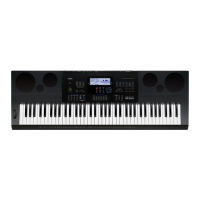Music Presets
E-50
3.
Use the buttons from L-3 ([A] POPS/ROCK/
DANCE) to L-8 ([F] USER RHYTHMS) to select a
music preset group.
• The L-8 ([F] USER RHYTHMS) button is for the user
preset group. For details, see “Creating a User Preset”
(page E-53).
4.
Use the dial or R-14 (–, +) buttons to scroll
through the music preset numbers until the one
you want is displayed.
• Tone, rhythm, and other settings will be configured in
accordance with the music preset you selected. For
details about the settings that are configured by a
music preset, see “Music Preset Settings” (page E-51).
5.
What you should do to start your performance
depends on the music preset you selected as
described below.
When the F, E, or H indicator is
flashing on the display:
When the F, E, or H indicator is not
flashing on the display:
6.
Play the melody along with the Auto
Accompaniment.
• The preset chord progression repeats the same
pattern. The number of measures in the progression
depends on the music preset that is selected. Shorter
progressions are made up of two to four measures,
while longer are 30 to 40 measures long. For some
chord progressions, a fill-in pattern will be inserted
automatically at the end of a progression pattern.
• You can change to a different music preset while Auto
Accompaniment play is in progress, or after stopping
your performance in step 7, below. Perform steps 3 and
4 of this procedure to change to another music preset.
If you change to a different music preset while playing,
the change will be executed after playback reaches the
end of the measure you are in when you make the
change.
7.
To stop playing, press the L-15 (SYNCHRO/
ENDING) button or the L-16 (START/STOP)
button.
• The D indicator continues to flash on the display
even after you stop playing. Pressing the L-16 (START/
STOP) button at this time will restart Auto
Accompaniment play.
8.
Press the R-15 (EXIT) button to exit the music
preset screen.
• You also can press the R-15 (EXIT) button while Auto
Accompaniment play is in progress. In this case, play
will stop and the music preset screen will be exited as
soon as you press the R-15 (EXIT) button.
• Instead of using the preset chord progression, you also can
use the chord keyboard (page E-26) to play Auto
Accompaniment chords, and you also can play with the
rhythm only. For details, see “To change music preset Auto
Accompaniment settings” (page E-52).
• During play using a music preset, you can change tone,
rhythm, tempo, mixer, effect, and other settings.
3 The flashing indicator means that the Digital Keyboard
is in synchro standby. Press a key in the chord
keyboard to the left of the split point (page E-17). This
will start Auto Accompaniment play along with the
chord progression.
3 Press the L-16 (START/STOP) button. This will start
Auto Accompaniment play along with the chord
progression.

